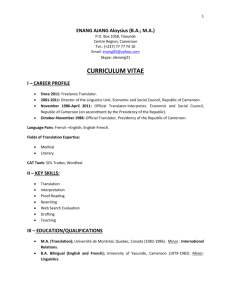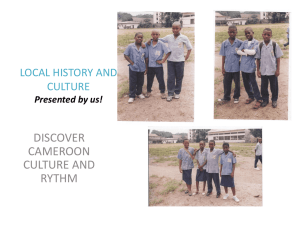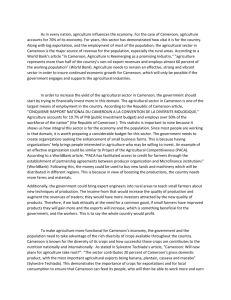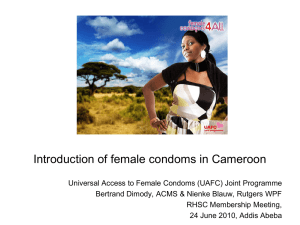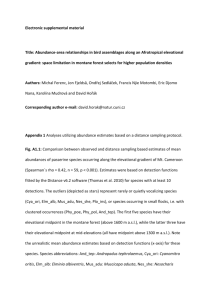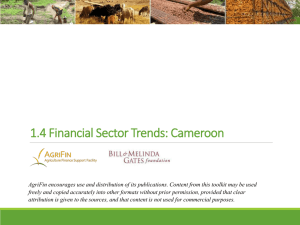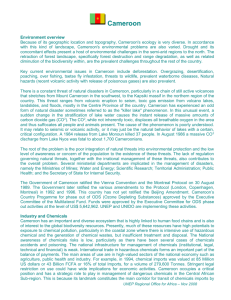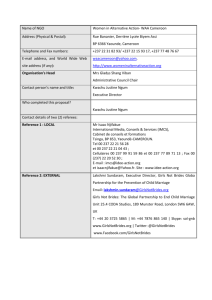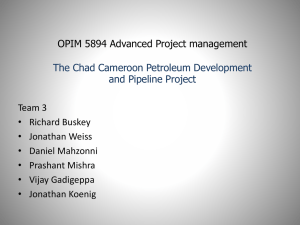Cameroon Facts and Figures - International Health Initiatives (IHI)
advertisement
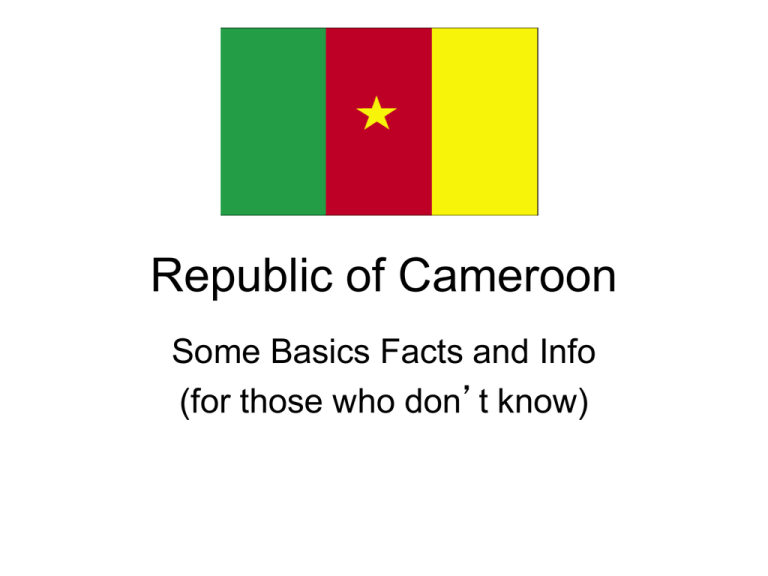
Republic of Cameroon Some Basics Facts and Info (for those who don’t know) Where in the world is it? • Located in Western Africa, bordering the Bight of Biafra. Random Facts Area Total - 475,440 sq km Land: 472,710 sq km Water: 2,730 sq km Capital City- Yaonde Population 1.74 million What is means in real terms, slightly larger than the state of California Geography Terrain: Very diverse from tropical on the coast to semiarid and hot in the North. Sometimes referred to as the “hinge of Africa”; throughout the country there are areas of thermal springs and Mount Cameroon, the highest mountain in SubSaharan west Africa, is an active volcano. Natural Hazards Mt. Cameroon last erupted in 2000, is the most frequently active volcano in West Africa. Lakes in Oku volcanic field have released fatal levels of gas on occasion, killing 1,700 people in 1986 Lake Nyos and Lake Monoun volcanoes periodically release poisonous gases Environment Waterborne diseases are prevalent; deforestation; overgrazing; desertification; poaching; overfishing Land use arable land: 12.54% permanent crops: 2.52% other: 84.94% (2005) Political Background • French Cameroon became independent in 1960 as the Republic of Cameroon. • In 1961 the southern portion British Cameroon merged to form the Federal Republic of Cameroon. • In 1972, a new constitution replaced the federation with a unitary state, the United Republic of Cameroon. • The country has generally enjoyed stability, which has permitted the development of agriculture, roads, and railways, as well as a petroleum industry. Despite slow movement toward democratic reform, political power remains firmly in the hands of President Paul BIYA People Population (2011 estimate) = 19,711,291 Median age – 19.4 Pop growth rate – 2.1%; Age Structure 0-14 years: 40.5% 15-64 years: 56.2% 65 years and over: 3.3% The sad and scary stats Infant mortality rate – 60.91/1000 (Ranked 33rd highest) Life expectancy – 54.39 years HIV/AIDS prevalence rate – 5.3% (13th highest globally) 610,000 living with AIDS (15th highest globally) Infectious Diseases Degree of risk: very high Food or waterborne diseases: bacterial and protozoal diarrhea, hepatitis A and E, and typhoid fever Vectorborne diseases: malaria and yellow fever Water contact disease: schistosomiasis Respiratory disease: meningococcal meningitis Langues, Religion and Ethnicity Ethnic Groups: Cameroon Highlanders 31%, Equatorial Bantu 19%, Kirdi 11%, Fulani 10%, Northwestern Bantu 8%, Eastern Nigritic 7%, other African 13% Religion: Indigenous beliefs 40%, Christian 40%, Muslim 20% Language: French and English (official) plus 24 major African groups Literacy and Education Primary to tertiary education – Average 10 years Total population age 15 and over can read and write : 67.9% males 77% females 59.8% Economy (Money, money, money…) GDP per capita - $2,300 USD Unemployment rate – 30% Population below poverty line – 48% Agriculture: coffee, cocoa, cotton, rubber, bananas, oilseed, grains, root starches; livestock; timber Industries: petroleum production and refining, aluminum production, food processing, light consumer goods, textiles, lumber. Bamenda The city is an amalgamation of three villages and the principal ethnic group is the Tikar. Bamenda was subjected to German colonialism in the late 19th century, after the defeat of the Germans in WW1 the League of Nations shared the colonial territories among victorious nations. Western Cameroon was administered jointly with Nigeria under the protectorate of the British until 1961 when following a plebiscite it attained independence by joining then the already independent République du Cameroun. Today, many of the city's inhabitants are English speaking, and Cameroonian Pidgin English is the main language. The rest of Cameroon, is Francophone. Health Education PT/OT Training – According to the World Confederation of Physical Therapy and World Federation of Occupational Therapists websites, there are no entry level PT/OT programs in Cameroon. 1 medical school in Cameroon which trains 85 students per year. Universite de Yaounde I Ratio of Health Professionals The professional doctor to patient ratio stands at 1.9 to 10,000 in the major cities and 1 to 40,000 in the rural areas. The WHO regional average is 2.3 per 10,000. However the number of nurses/midwives in Cameroon is higher 16 per 10,000 versus 10.9 in the region. 4000 practicing doctors in Cameroon were reported in Cameroon in 2005 of which about 1,500 where employed by the state and private sector for administrative work. While the number of recorded Cameroonian doctors practicing abroad was over 6,000. Health Spending and other stats Total expenditure on health per capita $122 USD Total expenditure on health 5.6% of GDP “years of life” lost by “injuries” = 7. Injury and Violence in Cameroon Juillard, C. et al; Patterns of injury and violence in Yaound Cameroon: an analysis of hospital data. Inj Prev2010;16:A166 doi:10.1136/ip.2010.029215.593 Reports on the patterns and frequency of injuries from Cameroon are scarce. This study explores the patterns of trauma seen at the emergency ward of the busiest trauma centre in Cameroons capital. Health records were reviewed for all trauma patients presenting to the ER. Patterns of injuries in terms of mechanism, date, age and gender were analysed. Bivariate analysis was utilised to explore potential relationships between demographic variables and mechanism of injury. 6234 injured people were seen. 71% were males; the mean age was 29 (SD=14.9). Nearly 60% were due to road traffic injury, 46% involving a pedestrian. Intentional injuries were the second most common mechanism, 55% of which involved unarmed assault. Falls victims and male patients were more likely to be admitted (p<0.001). Patterns in terms of age, gender and mechanism are similar to reports from other countries in sub-Saharan Africa. The magnitude of cases reported is high for a single institution in an African city the size of Yaound. As the burden of injury is predicted to increase dramatically in sub-Saharan Africa, prevention efforts in Cameroon are strongly warranted. Cameroon Consulates 1363 West 58th Avenue Vancouver, BC V6P 1W3 Fax: 604-261-8897 High Commission of Cameroon in Ontario 170 Clemow Avenue Ottawa, ON K1S 2B4 Phone:+1-613-236-1522 ; +1-613-236-1524 Email:cameroun@rogers.com
